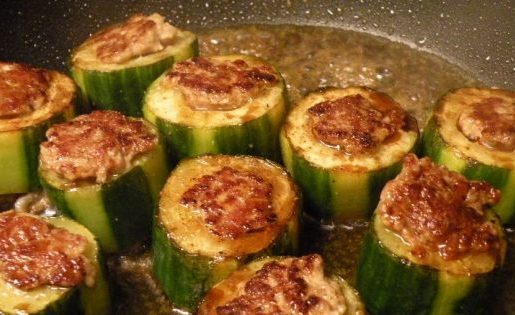Excellent taste!
The fruits are straight and densely covered with small bumps. They grow quickly and reach up to 50 cm in length.
Recommended for cultivation both in greenhouses and in open ground.
It’s time to sow cucumbers...
Recommended sowing period in a film greenhouse with emergency heating: April 18–28. The optimal age of cucumber seedlings is 28–30 days. Considering that cucumber seeds germinate on the 4th–5th day, and knowing when you can transplant the plants into the greenhouse, you can calculate the sowing date at home so that 28–30 days pass from germination to planting.
If there are no conditions or opportunities for hardening the seedlings and exposing them to sunlight, it is better not to rush with planting. In 30 days on a windowsill, with insufficient light, ultraviolet, and at a temperature that doesn’t drop enough at night, the plants will become tender, with long fragile stems and small pale-green leaves. In this case, it is enough to grow 15–20-day-old seedlings. They will be more transportable, have better survival potential, and adapt faster after planting. Seeds can also be sown directly into a bed if it is based on biofuel. In that case, the best time is early May.
The only old folk method worth mentioning for seed disinfection is to soak seeds for 10–15 minutes in vodka, then rinse and dry them. According to modern scientific recommendations, soaking the seeds on a moist substrate (gauze) for 2–3 hours in 3% hydrogen peroxide at +30–40°C improves germination and accelerates sprouting. From the wide variety of techniques, you can choose the optimal combination of seed preparation methods.
The following seed preparation scheme is used in production:
1. Warming to improve germination energy, sprouting rate, and yield is carried out at +60°C for 3 hours. At home, this can be done on a radiator. If it’s too hot, place several layers of newspaper underneath. Warm the seeds directly in paper packets. Sun-warming is also possible.
2. Disinfection with potassium permanganate against viral diseases. In a 1% solution for 20 minutes, or 0.5% for 30 minutes.
To prepare the solution: 1 g per half a glass of water (1%). Always use a freshly prepared solution, as it decomposes over time, especially in light. Pour over the seeds, stir occasionally, and after 20 minutes rinse thoroughly under running water using a small sieve. Spread on newspaper and dry.
3. Soak for 12 hours in a micronutrient solution the day before sowing.
Micronutrients (in mg per 1 L):
manganese sulfate – 100, boric acid – 100, zinc sulfate – 100, copper sulfate – 100, ammonium molybdate – 20.
You may use a complex micronutrient fertilizer and dilute it according to the instructions.
Tie the seeds in gauze and immerse them completely in the solution. The seeds swell and germination energy increases. After that, dry the seeds until they are free-flowing and sow immediately.
Do not pre-sprout cucumber seeds, as they become more susceptible to root rot.
Imported seeds are usually fully prepared for sowing. If you experiment with them, you may wash off the beneficial and protective substances applied by the producer and disrupt the intended preparation effect.
The best soil for sowing is peat mixed with sawdust in a 7:4 ratio, with lime (5–10 g per bucket) and cucumber seedling fertilizer. If garden soil is available, it can be used, but add peat and old sawdust, as garden soil often becomes heavy and crusts when dry. While the sprout struggles through the hardened surface, it weakens, resulting in poor seedlings. Before sowing, water the pots well with warm water; when excess water drains off, you can sow.
Do not water again until seedlings appear, as watering displaces air, which harms the seed.
Once sprouts appear, you can water for the first time. But if the seeds are old, germination may take a week or longer. If the soil dries before that, water lightly. The sowing depth should not exceed 1 cm (otherwise the hypocotyl elongates too much) and not be less than 0.5 cm, as shallower seeds develop weak roots. The optimal temperature for germination is +25+30°C. Avoid temperature fluctuations during germination. It’s better to keep the pots not on the windowsill (cold from below) but on a warm surface above the radiator, using a stand so they don’t overheat. The soil should be warm inside — farmers in the old days would test it barefoot to know when it was time to sow.
A convenient sowing method: place 1–2 seeds on the surface of each pot, then press each one down with your index finger to the depth of a fingernail (about 1 cm) and cover lightly with soil. Press gently. Cover the pots with film. When seedlings appear, remove the film. Where two plants sprouted or one pot stayed empty, transplant the extra plant into an empty pot. Carefully transplant the cucumber with a moist clump of soil into a pre-watered pot.
Transplant as early as possible, even before the cotyledons unfold. The first true leaf marks the last safe moment for transplanting. Later plants should not be disturbed.
When seedlings have two true leaves, inspect for deformities. A healthy cucumber develops leaves alternately. If the first and second true leaves appear opposite each other, remove the plant—it will form two weak growth points and yield poorly.
When growing seedlings at home, harden them on the balcony (place outdoors during the day). This produces strong, compact seedlings. If the balcony is glazed, they can stay overnight, but keep the door to the room open.
When growing seedlings in a greenhouse on a manure bed, cover them at night and uncover in the morning. Frost is dangerous at night, and overheating—during the day.
Fried cucumbers stuffed with meat
Ingredients:
2-3 cucumbers;
2-3 stalks of green onions;
1 piece of ginger (no more than 1 cm long);
200-230 g minced pork;
1 egg white;
4 tablespoons of sherry;
4 tablespoons of soy sauce;
4 teaspoons of sugar;
3½ tablespoons of vegetable oil;
salt and pepper - to taste;
2½ tablespoons flour;
300 ml chicken broth (can be from a cube);
1 tablespoon oyster sauce - optional
1 tablespoon of water;
1 pinch of coriander.
Cooking:
Cucumbers cut into medium pieces, a few centimeters high. With a teaspoon, remove most of the pulp from the middle to get barrels with fairly thin walls and bottoms. Chop onion and ginger. Mix with minced meat, protein, half the sherry, soy sauce and sugar, ½ tablespoon oil, salt and pepper. Dip the cucumbers in 2 tablespoons of flour and fill with the meat filling.
Heat the remaining oil in a large skillet over low heat. Brown the stuffed cucumbers for 2-4 minutes and place on a plate. In the same skillet over medium heat, bring the broth with the remaining sherry, soy sauce, flour and sugar, water and oyster sauce to a boil. Throw in the cucumbers and cook for 10-15 minutes. Then put on a plate. Increase the heat, add coriander to the sauce and simmer for 3-5 minutes or a little longer so that at least a third of the moisture has evaporated.
Drizzle the stuffed cucumbers with the sauce and serve.













